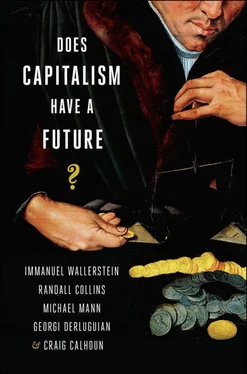Immanuel Wallerstein - Does Capitalism Have a Future?
Здесь есть возможность читать онлайн «Immanuel Wallerstein - Does Capitalism Have a Future?» весь текст электронной книги совершенно бесплатно (целиком полную версию без сокращений). В некоторых случаях можно слушать аудио, скачать через торрент в формате fb2 и присутствует краткое содержание. Город: New York, Год выпуска: 2013, ISBN: 2013, Издательство: Oxford University Press, Жанр: Публицистика, sci_economy, на английском языке. Описание произведения, (предисловие) а так же отзывы посетителей доступны на портале библиотеки ЛибКат.
- Название:Does Capitalism Have a Future?
- Автор:
- Издательство:Oxford University Press
- Жанр:
- Год:2013
- Город:New York
- ISBN:978-0-19-933084-3
- Рейтинг книги:5 / 5. Голосов: 1
-
Избранное:Добавить в избранное
- Отзывы:
-
Ваша оценка:
- 100
- 1
- 2
- 3
- 4
- 5
Does Capitalism Have a Future?: краткое содержание, описание и аннотация
Предлагаем к чтению аннотацию, описание, краткое содержание или предисловие (зависит от того, что написал сам автор книги «Does Capitalism Have a Future?»). Если вы не нашли необходимую информацию о книге — напишите в комментариях, мы постараемся отыскать её.
Does Capitalism Have a Future? — читать онлайн бесплатно полную книгу (весь текст) целиком
Ниже представлен текст книги, разбитый по страницам. Система сохранения места последней прочитанной страницы, позволяет с удобством читать онлайн бесплатно книгу «Does Capitalism Have a Future?», без необходимости каждый раз заново искать на чём Вы остановились. Поставьте закладку, и сможете в любой момент перейти на страницу, на которой закончили чтение.
Интервал:
Закладка:
All five of us consider the narrowing of global inequality gaps a desirable and realistic prospect. In Wallerstein’s words, this would minimize pain in the shorter run and maximize the potential for a better world transformation in the medium to longer run. Michael Mann finds here a major source of continued market vitality or even the foundations for a more egalitarian and prosperous world capitalist order modeled on the post-1945 social democratic recovery in Europe. This looks like a good prospect, but can it be compatible with the political economy of capitalism as measured by the rationale of private profit? Neither Wallerstein nor Collins considers the “rise of the rest” as contradicting their hypotheses regarding the future demise of capitalism. To the contrary, the proliferation of new capitalist players in the world markets or the mobile and globally competing educated middle classes would aggravate the dilemmas of capitalism.
So far we remain in the mode of extrapolating the near-past into the near-future. What about major structural shifts, either within high-tech capitalism, in the global world-system, or in the ecology of the planet?
SYSTEMIC LIMITS VERSUS ENDLESS INTENSIFICATION
Michael Mann advances an optimistic view of the survival of capitalism, but a rather pessimistic view of environmental crisis. The “rise of the rest” opens virtually limitless new frontiers for capitalism, at least in the foreseeable future. World demographics, and therefore much of the world politics and economy now profoundly affected by the massive growth in the poorer countries and the resulting global migrations into towns, will eventually stabilize. Mann is skeptical of the existence of pansystemic structures and cycles. Instead, he suggests a kaleidoscopic recombination of the four non-congruent and distinctly shaped networks of social power: ideological, economic, military, and political. Leaving his prognosis underdetermined as a matter of principle, Mann refrains from making specific predictions except that capitalism will continue to be resilient, especially if it is steered by more pragmatic liberal-labor politics.
Nevertheless, Mann theorizes from a structured viewpoint elaborating on Max Weber. Wielding his four-dimensional template of power, Mann shows that events become turning points when leading power sources intersect. In the early twentieth century it was the combination of world war with capitalist crisis exacerbated by ideology and politics. In the twenty-first century the combination of rampant capitalist growth with the stalemate of pluralist politics and national self-centeredness points toward ecological crisis. Degrees of contingency exist, but within the structural tendencies laid down by historical development of the four sources of power. It is chiefly because there are multiple causes that unpredictable intersections occur. Here Mann disagrees with Collins and Wallerstein on the importance of crisis in the economic institutions of capitalism. Instead he emphasizes that environmental strains will rise to catastrophe, unless political mobilization prevails to do something about it. Thus Mann’s big contingency is in the intersection of the environmental (economic in the largest sense) and the political spheres.
Craig Calhoun agrees with Mann about the centrality of external, especially environmental threats to capitalism. Like all of us, Calhoun argues that the future is not fully determined and therefore it is open to political action. He argues, though, both that internal system risks are more challenging to capitalism than Mann suggests, and that for capitalism to survive there must be a renewal of social institutions that on the one hand enable and facilitate capitalism and on the other hand compensate for the costs and damages it now externalizes as burdens for society at large. The question then is, in the thinking of Wallerstein and Collins, whether such globally escalating costs could be at all sustained by capitalism. The question is not rhetorical. Social scientists should be watching and measuring the dynamic capacities of capitalism to see whether the costs are being met by the generation of new wealth along with the growth or decline in political mechanisms for spreading benefits across the globally connected social structures.
Mann and Calhoun both suggest that a deep environmental crisis could come soon and challenge a still economically viable capitalism. Collins and Wallerstein see the environmental risk as longer term and capitalist crisis more imminent. Collins reads the scientific consensus of environmental projections as pointing to major crisis around the year 2100. Mann argues that severe ecological damage will threaten some countries’ survival already by 2030–50. Yet Collins and Wallerstein project full-scale capitalist crisis in the decades around 2040. They thus suggest that we will confront capitalist crisis before environmental limits become terminal. If one holds the Collins/Wallerstein view, it is tempting to speculate that a socialist resolution to a capitalist crisis would change political structures to such a degree that the ecological crisis could be reasonably handled, as it might well not be if capitalism continues as usual. Mann has a different take on this. Any major capitalist crisis would considerably lower GDP levels, thus easing the environmental crisis (provided warming had not already gone too far). He sees three villains producing climate change: not just capitalism, but also the nation-state and the ordinary mass-consuming citizen. A solution to the crisis would involve reining in and reforming all three. Whether capitalism or socialism (or anything else) emerges viably from the crisis, they would have to be in radically new forms.
Second, both Mann and Calhoun place more emphasis on capitalist dynamism outside the West. Indeed, for Mann, it is not the end of capitalism, but rather the ecological crisis that is global. Hence it cannot be argued that while capitalism and geopolitical hegemony will decline for the United States and Europe, world leadership will pass to other triumphant regions of the globe such as East Asia or a coalition now going under names like the BRICS. However, environmental scientists hold at present that the worst environmental catastrophes will begin in China, South Asia, and Africa. This projection questions the prospect for emergent global leadership providing an alternative to the West. The ecological crisis, according to Mann, could be the end of everybody. Less rhetorically, we have to consider not two alternatives but three: terminal crisis of capitalism as a world-system; decline of the older capitalist hegemons and their replacement by new ones; and global-scale ecological shock, with resulting transformations yet to be envisioned. Collins and Wallerstein argue for the first of these; Mann for the third.
Immanuel Wallerstein and Randall Collins read the picture in different yet mutually compatible ways. They see capitalism as a global system or, if you wish, a hierarchical ecology of economic food chains and market niches. Like any complex system, it has its interrelated structures, dynamic trends, and therefore it must have its ultimate limits. Even if the systemic limits could be expanded thanks to new geographies and technologies of production, they cannot be altogether abolished. Nobody can now specify the institutions and parameters of the world coming after capitalism. Here Craig Calhoun interjects by reminding us how much in such world transitions depends on the contested political choices. Nevertheless Collins and Wallerstein insist that capitalism is nearing its limits, and they make one big prediction: there will be a world transition. They both clearly specify what structural processes are pushing toward the predicted transition, thus opening their hypotheses to critical scrutiny and the possibility of empirical testing. Georgi Derluguian presents the Soviet example as a theoretical and empirical test of what has worked or did not work in the past predictions of Collins and Wallerstein. The trajectory of the Soviet bloc shows how a large systemic unit reaches the limits of its own success and perishes from a combination of structural weights and purely contingent factors.
Читать дальшеИнтервал:
Закладка:
Похожие книги на «Does Capitalism Have a Future?»
Представляем Вашему вниманию похожие книги на «Does Capitalism Have a Future?» списком для выбора. Мы отобрали схожую по названию и смыслу литературу в надежде предоставить читателям больше вариантов отыскать новые, интересные, ещё непрочитанные произведения.
Обсуждение, отзывы о книге «Does Capitalism Have a Future?» и просто собственные мнения читателей. Оставьте ваши комментарии, напишите, что Вы думаете о произведении, его смысле или главных героях. Укажите что конкретно понравилось, а что нет, и почему Вы так считаете.












